Possible Solutions to Murder in Milwaukee
Should it be treated as health epidemic? And why are shootings now more lethal?
Last week’s article on homicides in Milwaukee elicited considerable interest and some thoughtful responses. The column was based almost entirely on the wealth of data from the most recent annual report by the Milwaukee Homicide Commission on homicides and non-fatal shootings. How does Milwaukee fit into the broader picture nationally and in Wisconsin?
Gun deaths have plummeted in the United States since the early 1990’s as shown in the graph below. There is no overall consensus as to the causes of this decline. Among the possible explanations advanced are the collapse of the crack epidemic, higher rates of incarceration, reduction in lead exposure, the aging of the baby boom generation, more police, and the legalization of abortion (leading to fewer unwanted children).
The Pew Research Center lists some of the possible causes, concluding that “there is no consensus among those who study the issue as to why it happened.” A paper by the economist Steven Levitt lists 10 possible causes and rejects six of them.
The Pew report also notes the public is not aware of this decline. Far more people wrongly believe violent crime has risen.
A survey done every two years by the University of Chicago finds that gun ownership has declined. It also found that interest in hunting has declined. Since the number of guns has steadily increased, this would suggest that fewer people have more guns.
The lack of agreement on the reasons for the dramatic decline of homicides—and other violent crimes—in the 1990s raises concern that murders could increase and the reasons could be equally unclear. Milwaukee is not alone in reporting an uptick in murders. Chicago has recently been notable for its violence. The chart below summarizes data from the Major Cities Chiefs Association showing a 9 percent increase between the the 2015 and 2016 first quarters in murders. This uptick contributes to concern that the decline in crime may be reversing. (Milwaukee shows a slight decline in the rate so far this year.)
Among the states, Wisconsin historically has been at the low end of the murder rate. The next graph shows the Wisconsin murder rate since 2001 based on the FBI crime statistics. The rate since the legalization of concealed carry, shown in red, shows a slight uptick, but well within historical values. This result doesn’t support the prediction made by some advocates that allowing guns to be concealed would reduce crime. By the same token, it’s hard to argue that the small jump in rates post-law was caused by the change in the law, since they are well within the historical range. But the restrictions the law places on the collection of information makes it difficult to fully measure the impact of concealed carry.
Of Milwaukee’s three major ethnic groups—blacks, Hispanics, and non-Hispanic whites—blacks have been hit far more heavily by the recent spurt in homicides. The chart below shows the homicide rate per 100,000 people for the three groups.
Between 2014 and 2015, the rate for African Americans jumped from 28 to 53. This reflects a nearly doubling of the number of people killed, from 66 to 122. This compares to a rate of 12 for Hispanics and 4 for whites.
What explains the sudden jump in African American murder victims? One way of looking at it is as a combination of two things: a steady rise in the shooting of African Americans and a sudden jump in the lethality of those shootings.
The next chart illustrates the total rate of shootings—fatal and non-fatal–for members of the same three groups since 2010. During this period African Americans were much more likely to be victims of shootings at the start and their rate steadily increased from year to year.
The dotted line is the trend line during this period. The coefficient of determination of almost 95 percent means that 95 percent of the variation in the annual rate is explained merely by the passage of time.
In short, the increase in the total shootings of blacks isn’t a surprise by historical standards. The surprise, as the next graph shows, is the spike in deaths from those shootings; the lethality of those shootings rose from 12 percent to 18 percent.
Without further information, it is hard to determine the cause of this increase in lethality. It could reflect just random variation. Alternatively, it might reflect the motivation for the shootings. For example, it seems plausible that if there are gunshots during a robbery, the participants may scatter; if however the motivation is revenge there may be a more of a motivation to stick around to finish the job.
One of the most promising approaches to reducing gun deaths is to treat them as a public health epidemic, much like the successful campaigns against various diseases. Doing so would have several advantages. For one, it would concentrate on finding solutions rather than the recent tendency by politicians and others to scapegoat.
Take the analogy of a disease that is spread by drinking polluted water. Doctors and hospitals may be able to treat the sick patient but they are usually not equipped to stop the spread of the disease. That depends on identifying the vectors that cause the spread and figuring out an effective way to interrupt these pathways.
When it comes to violent crime, police play a role analogous to doctors and hospitals when treating disease. The doctors and hospitals treat the patients who have contracted the virus; they are not equipped to drain the swamps where the mosquitos who spread the virus breed. Similarly police are trained to react to crimes and identify the suspects. However, to attack the police for not changing the conditions that cause young men to commit crime is unproductive scapegoating.
Data Wonk
-
Life Expectancy in Wisconsin vs. Other States
 Dec 10th, 2025 by Bruce Thompson
Dec 10th, 2025 by Bruce Thompson
-
How Republicans Opened the Door To Redistricting
 Nov 26th, 2025 by Bruce Thompson
Nov 26th, 2025 by Bruce Thompson
-
The Connection Between Life Expectancy, Poverty and Partisanship
 Nov 21st, 2025 by Bruce Thompson
Nov 21st, 2025 by Bruce Thompson




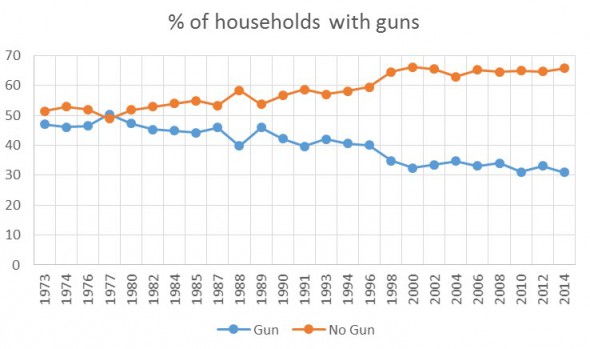
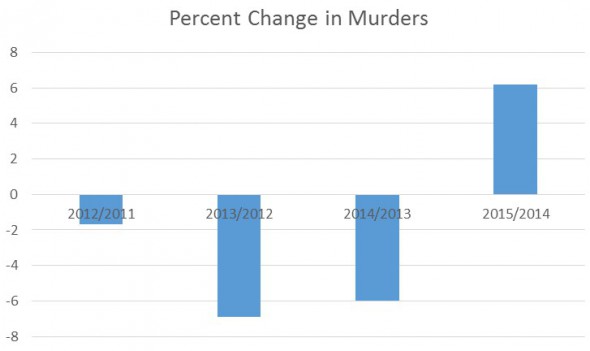
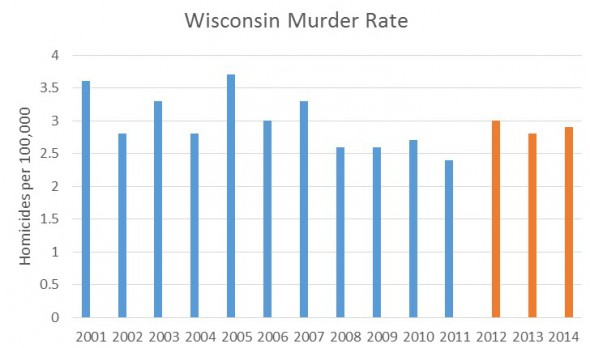
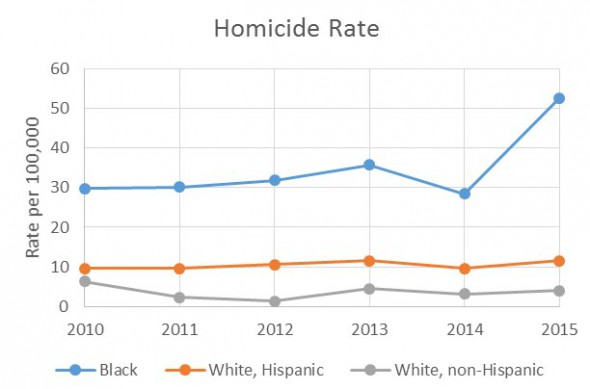
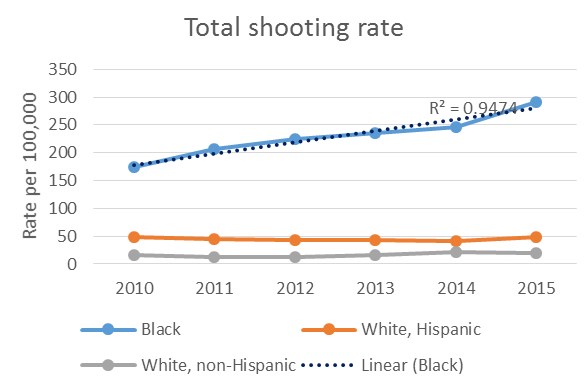
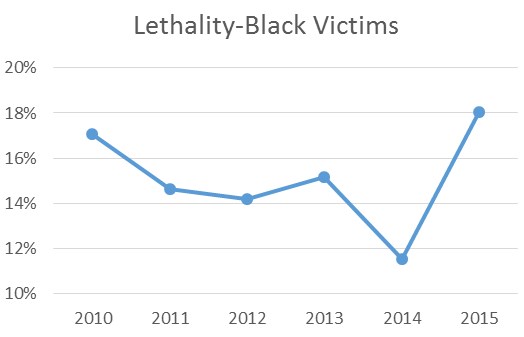



















Here’s a start: http://www.npr.org/sections/thetwo-way/2016/06/14/482041613/gun-violence-a-public-health-crisis-says-ama
Something to think about
…Like it or not, in places like Milwaukee’s North-side and Chicago’s South-side, we have a child soldier problem. One only need to turn on the radio, click on YouTube, or browse social media sites to see the countless instances in popular youth culture where young black men are willfully, almost joyously, self-identifying as “soldiers”. Whether the nightly car-jackings and shootings on Atkinson Avenue are comparable to the amputations and rapes during the civil war in Sierra Leone, the difference is merely quantitative and a matter of degree, while the root truth—that there exists a veritable “army” of young black boys, drug-fueled and heavily-armed, loosely organized around promises of a better life—remains the same. Front lawns have become front lines, and those same hardscrabble patches of grass where I encountered that young boy next to a pool of blood have become the battle sites of what can rightly be called a civil war. Brother versus brother, neighbor versus neighbor, daily skirmishes play out with alarming frequency and disheartening regularity that we would be remiss to discount the interconnectedness. Yet, this is precisely what we are doing when we address the day’s fresh horror as an isolated incident, rather than the most recent flare-up of long-standing conditions that have desensitized large swaths of the inner city populace.
What we do know is that the use of Truth and Reconciliation Commissions (TRC)–to record, hold accountable and re-integrate those child soldiers who have blood on their hands–has worked. I am not suggesting a replacement of the criminal justice system, rather an adjunctive and parallel mechanism where child witnesses are heard and recorded and where a child version of the final report is produced as it was in Sierra Leone. The ICTJ has a road map for the implementation and training of participants in a TRC. I am reasonably certain that if Mayor Barrett, Council President Hamilton, Chief Flynn, John Chisholm and myself wrote a grant proposal to the MacArthur Foundation and/or George Soros’ Open Society Institute, that we could get preliminary funding to explore parallel options to address the generational problem of entire communities suffering from the same mass urban psychosis normally associated with war zones. It is my most ardent hope that, maybe one day, the little boy on the sidewalk will stop calling my office.
To read full piece go to the blog piece written two weeks ago called WarChild http://www.theshellowgroup.com and go to blog
Let us simply get rid of phony lies and excuses
by honestly admitting and discussing and describing a
central, continuing, increasing tragedy in this nation of ours.
Let us simply admit how many fortunate citizens and politicians
have learned to remain isolated from themselves
so do not care to give help and hope to
“those“ less fortunate.
Let us simply admit how many affluent citizens and politicians
have learned to remain isolated from others
so do not care to give help and hope to
“those“ less affluent.
Let us simply admit how many privileged citizens and politicians
have learned to hoard as much personal wealth as possible
so give as little help and hope as possible to
“those” less privileged.
Let us simply admit how many fortunate, affluent, privileged citizens and politicians
have learned to remain isolated from themselves and therefore others,
so turn their eyes and minds and hearts away
so they cannot see and fully feel the
suffering many millions of people
in our towns and our cities and our states in our country
endure without hope and effective help.
In times not many decades ago, before the proliferation of handguns, two up close, hardened, very angry men were forced to use only their fists to hopefully pummel their foe to submission, to hopefully beat their foe to unconsciousness, but seldom to death.
The deterrence of this up close violence was a real, unforgotten fear of suddenly being awakened, on the ground, beaten down and out himself, awakened suddenly by the humiliation of his own pain, by the tears of his own flowing blood and by only helplessly cowering at the sight of his towering, gloating victor dancing above and around him like Ali waiting for more.
Looking back, maybe these old school ways of solving disputes were the best deterrence of this violence, when both men feared their own painful consequences of manly humiliation.
Our interpersonal handgun violence that frightened, childish cowards inflict on their victims is far too distant and easy and safe and impersonal.
Handguns allow frightened, childish cowards the luxury of killing another human being from a safe distance with little risk of being pummeled to death in return.
Gun violence is a safe way for frightened, childish cowards to try to get what he wants at the expense of others.
The frightened, childish coward with gun in hand only pretends to be a real man.
The frightened, childish coward somehow tries to convince himself and others that he somehow, suddenly deserves respect as a real man when, in truth, he is only a frightened, childish coward.
“It’s a hard rain’s a-gonna fall”
“where the people are a many and their hands are all empty,
where the pellets of poison are flooding their waters,
where the home in the valley meets the damp dirty prison,
where the executioner’s face is always well hidden,
where hunger is ugly, where souls are forgotten,
where black is the color, where none is the number.”
We try to be hard on the outside.
We try to be hard on the inside.
“There’s battle lines being drawn” between white citizens and black citizens in numerous towns and cities and states across the United States.
“You step out of line, the man come and take you away.”
“What a field day for the heat.”
Some police officers, like most of us, only pretend to be strong and brave to only hide we are weak and afraid.
Once the backbone of “the authorities” is angrily challenged face to face and nose to nose, genuine fear can easily become sheer terror and blind panic.
Hidden fears sometimes cause us to strike out against the big, black shadows “you’ve got to be carefully taught to hate and fear.”
“You step out of line, the man come and take you away.”
“What a field day for the heat.”
Especially young, black males have been ostracized and minimized and trivialized and symbolically castrated and forced to finally proclaim in protests, like Muddy Waters singing his song, “I’m a man!”
Especially young, black males are sick and tired of being profiled and bullied and disrespected and discriminated against by “the authorities.”
Especially young, black males are sick and tired of being ignored and underemployed and unemployed and poverty stricken and without hope.
“You step out of line, the man come and take you away.”
“What a field day for the heat.”
“It’s a hard rain’s a-gonna fall.”
Baltimore, Milwaukee, Ferguson and Watts illustrate the need for and even predicts what will become larger, more common, necessary social uprisings. Social uprisings by ostracized, downtrodden, disrespected citizens of color, especially black citizens.
I anticipate that brothers and sisters of all colors will soon reemerge from confined darkness into the light and return with renewed strength and power, once again squaring off defiantly across battle lines…to march across battle lines against young, white police officers and lay claims to their birthrights mostly the citizens of the privileged, white ruling class enjoy.
And in the near future throughout the U.S., there will be last resort and therefore necessary social uprisings to once again demand social justice such as equality and opportunities and fairness and respect and freedoms and employment with a living wage and caring and justice in the streets and in the courts and neighborhood safety and empathy and insured health care and high quality teachers in high quality schools for all people of all colors and races living in the U.S.
Hopefully then, in the near future throughout the U.S., brothers and sisters of all colors will finally rise to speak with a powerful voice that will be heard and will no longer be silenced!
Hopefully then, in the near future throughout the U.S., our elected “leaders” and our elected “representatives” will finally provide truly effective, enduring, meaningful, life-changing, life-renewing assistance to our poverty-stricken, downtrodden, oppressed citizens of color.
Hopefully then, in the near future throughout the U.S., our downtrodden, disrespected, abused citizens of color, especially black citizens, will reemerge from confinement and will finally run to the light with renewed strength and power!
Hopefully then, in the near future throughout the U.S., brothers and sisters of all colors will finally, soon rise up and reemerge and return with renewed strength and power to reclaim the destiny of their potential greatness!
Hopefully then, in the near future throughout the U.S., finally rise up to lay claims to your birthrights mostly the citizens of the privileged, white ruling class enjoy such as freedom and equality and education and respect and employment and opportunity and justice!
Hopefully then, in the near future throughout the U.S., finally rise up and triumph over the privileged, white ruling class sins that continue ignorance and hate and poverty and prejudice and confinement and slavery!
Huh? Wuh? Quite a diatribe Don but you sound like you are out to lunch. Somebody check- what’s the 2-parent household rate for Indians, Asians, Whites, Hispanics, and Blacks? My guess is the higher the 2-parent household rate, the lower murder rate. After a long day, my wife and I have to dig deep to a) get our kids to activities, b) help with homework, and c) teach our kids values. It’s not an easy thing to do. I’d guess that those groups with higher 2-parent household rates feel the same and don’t have much sympathy for those that don’t make the effort.
“I’d guess that those groups with higher 2-parent household rates feel the same and don’t have much sympathy for those that don’t make the effort.”
That’s the problem, because you refuse to look beyond the symptom of the single parent family to find a cure, because maybe this makes you feel somehow superior.
The symptom of the culture is a single parent household. A baby is seen as an accessory. I’ve been in the schools and heard these things said. They don’t want a relationship or a family and that’s why procreating is not done responsibly. Sex is fun and babies get attention. They also cry at night, poop themselves and need to be fed on a regular basis. But the young mother doesn’t realize that until the baby is there, by then the father is long gone; dead, jailed, or run off by the family. It’s way beyond one problem to “cure” these issues. These kids raise themselves from a very young age. It’s more like a no parent household. Money needs to be spent educating young adults and parents about raising a healthy (mind, bodied, spirited) children, instead of just giving them a bigger paycheck for having more.
The symptom of the culture is a single parent household.
No.
There are plenty of single parent households where people manage to raise children who aren’t gangbangers.
The problem is that even the single parent in those scenarios doesn’t care.
And I don’t know how you make them care.
Sean hasn’t the number of teen parents been going way down in recent years? That’s a good thing right? Jason you talk like someone who is making wild assumptions from the outside looking in. Your lack of sympathy isn’t impressive. You think you and your wife are the only parents who make tough decisions and sacrifices for your children? Hint: you’re not.
Joe (10) the overwhelming rates and glorification of single parents is definitely a symptom of the culture. I would agree though its how the single parent raises that child. Like I said they treat babies as an accessory. What do you do with a product when its worn out, not cute, you throw it away. They essential put these kids on the street once they lose their luster of being a cute baby.
Sean do you have firsthand experience with this? You personally know tons of people who glorify being a single parent and then force their kids onto the street once they aren’t cute babies? I find that really hard to believe.
Sean I think you’re missing my point. Single parents don’t all “treat babies as an accessory.” So stop castigating single parents as a whole.
I grew up with 2 siblings in a single parent household and we are all relatively well-adjusted individuals, and certainly aren’t gangbangers. There are plenty of other families like ours.
As usual there are people who bring nothing to the discussion because of prejudice, with absolutely no intention to look at the causes.
Good morning all Chapters 10 and 11 of Why They Kill by Richard Rhodes strongly suggest that abuse/trauma is the foundation of most/all violent behavior. More importantly if the abuse/trauma is resolved (healed). The medical model is clearly a very good way of understanding violent behavior. Another way is to see a person’s belligerent behavior (which is the human response to abuse/trauma) as a CRY FOR HELP not an affront to authority. Paul Tough in his latest book has a chapter on delinquency which suggest that punishment (suspensions) is not the solution.
Call me if you are interested in following up Tom Spellman 414 403 1341
Single, especially young, mothers are both a cause and a symptom of the challenges of the inner city. There is definitely a prevailing culture for many in the inner city that falls in line with the statements made here. However, there’s a difference between making generalizations based on trends vs stereotyping an entire group. Some people here sound more like the stereotyping side of the equation.
That being said, single parent households DO face a much greater struggle. With only one parent you’re more likely to be poor, for the children to do worse in school, and a host of other issues. Of course, there are still plenty of great single parents and plenty of terrible parents who are married. So it’s not a guarantee either way.
With all that in mind, it really would be a great boost to the city if we can impart a culture of a strong nuclear family (in whatever iteration that family may look) that values both parents being involved in their children’s lives and providing a strong foundation and example to pass long to future generations. Somewhere along the line the strong African American family unit became less common and we began seeing more single mothers and grandparents raising children. If we can reverse that trend the city would likely see improvements in many other areas. As Vincent pointed out, we’ve already seen a significant drop in teen pregnancy… now if only we could build on that trend with more dual parent households.
Notice the flat the lines are for every group other than blacks.
This has been true for decades. The missing part of your story is the decline
in crime during the previous decades is also entirely African American phenomena.
Nothing changes much in America besides the crime rate in the black community.
I have read and re-read the back and forth discussions about root causes. Kids– where violence strikes young– live with these root causes. The question I posed is how to create an inter-generational memory of their traumatic experiences and with that solutions for the root causes may emerge as this community and its offenders can find reconciliation. It is not the fast track toward peace in our time. But, I think all commentators agree that what we are doing isn’t working..
Robin Shellow
http://www.theshellowgroup.com/site/2016/06/07/war-child/.
“Little child
runnin’ wild.
Watch a while.
You see he never smiles
Broken home.
Father gone.
Mama tired
so he’s all alone
Kind of sad.
Kind of mad.
Ghetto child
thinkin’ he’s been had.
In the back of his mind he’s sayin’
‘Didn’t have to be here.
You didn’t have to love for me.
While I was just a nothin’ child
why couldn’t they just let me be?
Let me be, let me be, let me be.’
One room shack
on the alley-back.
Control, I’m told
from across the track.
Where is the mayor
who’ll make all things fair?
He lives outside
our polluted air.
And I didn’t have to be here.
You didn’t have to love for me.
While I was just a nothin’ child
why couldn’t they just let me be?
Let me be, let me be, let me be.
I got a Jones.
runnin’ through ma’ bones.
I’m sorry son.
All your money’s gone.
Painful rip
in my upper hip.
I guess it’s time
to take another trip.
Don’t care what nobody say.
I got to take the pain away.
It’s getting worser day by day
and all my life has been this way.
Can’t reason with the pusher man.
Finance is all that he understands.
You junkie, mama cries, you know.
Would rip her, but I love her so.
Love her so, now.”
Curtis Mayfield – Little Child Runnin’ Wild
I have an image in my head and
if I could I would draw it.
My image is of our mighty, towering city elevated
with its central weight supported by strong stilts of homes…
homes breathing with families filled with dreams…
dreams to learn to earn to rise.
But the weight of our towering city elevated
slowly presses down on the core.
And homes once filled with dreams
slowly collapse on the bowed and broken.
And the once strong stilts of homes
slowly become empty, rotting shells.
And our mighty, towering city elevated
crashes, hammers down on the core.
And the breath of dreams is slowly smothered…
dreams to learn to earn to rise.
I am suggesting a new set of tools utilizing the impact on potential perpetrators and other stakeholders that may allow what has yet to be destroyed to be re-built on a foundation that is stronger because perpetrators, victims and community stakeholders have all heard a tale of two cities. What started with the destruction wrought by the crack epidemic threatens the already weakened foundations of Milwaukee’s Children as we buckle our seat belts for the heroin holocaust.
Robin Shellow
http://www.theshellowgroup.com/site/2016/05/09/the-heroin-holocaust/